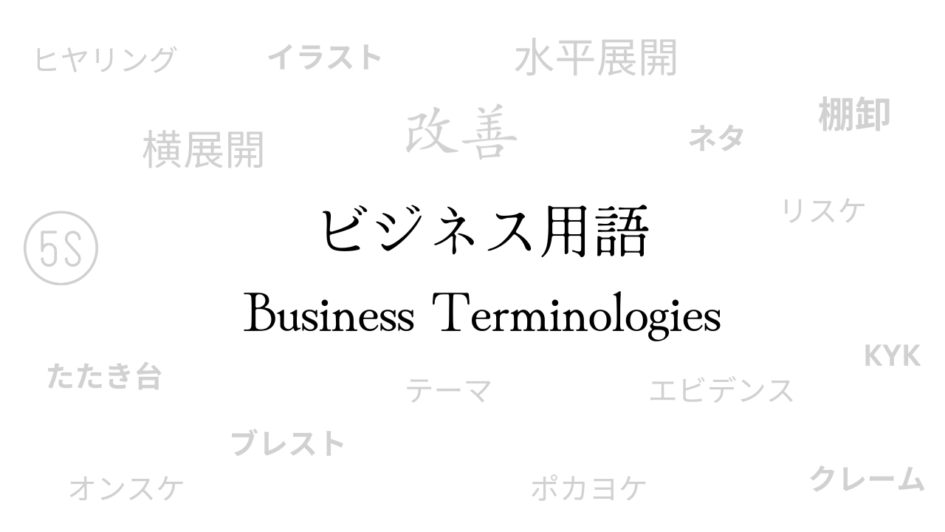Anyone who works at a Japanese company or aspires to work there will find this blog to be of great use. During formal meetings as well as casual conversations, it is typical to utilise either japanese, katakana, english or other language terms. A person with a better knowledge of these terms will be able to understand and communicate in a better way with the co-workers. I’ve listed here a few of the common business terminologies used in Japanese companies.
General Terms
These are the words used to describe workplace events, specific activities and their consequences, and the materials to do tasks. Since these words are short, there is no need of lengthy explaination. Here i would like to list out a few of the workplace terms along with their meaning.
棚卸 tanaoroshi
This is one of the frequently used words in factories & warehouses for taking stock of product count, checking the quality of products. The term when applied to everyday work, provides a clear picture of inefficient areas, tasks that need to be prioritised, and so on. The other word for this is visualizing tasks and workloads.
たたき台 Tatakidai
The term tatakidai refers to the tool/metal base on which blacksmiths pound hot metal to shape it. At work, the same word tatakidai is used to denote a draft, prototype, or a rough blueprint. The draft will serve as the foundation for further work in order to finalise a plan.
終日 shuujitsu
This term is commonly used at work to denote working hours or the time between clocking in and out.
五月雨式 samidareshiki
The word samidareshiki refers to “Early summer/May rain” that is intermittent. The same word is used to describe a situation in which you contact someone constantly. Usually a word of apology will go along this word in a sentence.
虎の巻 Toranomaki
This term can be traced back to an ancient Chinese text of military tactics. Because the secrets of tactics were mentioned in the Tiger volume of the book, it came to be known as Tora no maki, or the Tiger scroll. Nowadays, the Tiger scroll is an idiom that implies “Key” or “Book of knowledge”. The master text for a specific topic is known as the “Tora no Maki,” which refers to the traditional Japanese technique of writing texts on long scrolls. It is common to see the word Tora no maki at workplace or on the title of books. The word is commonly used for a text book, answer book, reference book, work handbook, guide book, and so on.
Business Practice Terms
These terms indicate a set of ideas, guidelines or ethics in order to bring about improvements in communication flow, risk assesment, problem resolution, quality and efficiency.
報連相 hourensou
In a workplace, having effective communication is vital to building relationships with trust, and for this reason hourensou is exemplified.
Hou-Ren-Sou is an abbreviation of three words: houkoku, renraku, and soudan – reporting, informing, and consulting. Funny enough, it sounds the same as the Japanese word for “spinach”. This method is employed by the great majority of organisations and is strongly embedded in the country’s working culture.
危険予知活動 kiken-yochi-katsudo
Kiken Yochi Katsudo translates to Hazarad Awareness Activities. It refers to the proactive process of identifying potential hazards or risks due to unsafe conditions or actions before they occur so that accidents or incidents at workplace can be prevented.
横展開 yokotenkai | 水平展開 suiheitenkai
Yokotenkai or Suiheitenkai translates to “best practice sharing”. It is an essential part of long term success in a lean culture. Achieve a result, and then share the results, learn from it & adopt it wherever applicable, and immediately recreate and multiply the success.
ポカヨケ pokayoke
Poka Yoke means “Mistake proofing” or avoiding inadverdent errors. It is utilised in both the manufacturing and service industries. Its purpose is to eliminate product/process defects by preventing, correcting, or drawing attention to human errors as they occur.
5S
Seiri, Seiton, Seiso, Seiketsu, and Shitsuke are the five Japanese words that stand for Sort, Set, Shine, Standardise, and Sustain. The essence of 5S can be summarized as : “Only what is needed, in its proper place, clean and ready for use”. Its simplicity, practical applicability, and visual nature makes it an easy methodology for all types of companies from manufacturing plants to offices.
Katakana Terms
Katakana is typically used to write foreign words and the names of foreign individuals and places. However, katakana is sometimes used to write words that can also be written in hiragana or kanji. This is to emphazise the kanji words or to bring about rhythm in a sentence. The following are some words that are commonly used at work in casual chat or in meetings.
テーマ・ネタ Topic
This refers to the topic of discussion.
オンスケ Onschedule | リスケ Reschedule
The original words in english are on schedule and reschedule. On schedule means the meeting or plan is on schedule. If a schedule change is required, the term reschedule will be used.
クレーム Complaint
This refers to an opinion or requirement from a customer in case of dissatisfaction w.r.t a defective product or bad service. The customer can demand either improvements or necessary actions.
イラスト Illustration
The original english word is illustration. An illustration is a visual portrayal of a text, concept, or process that is intended for use in print and digitally produced media.
エビデンス evidence
The english meaning of this word is proof. At a Japanese workplace this term is used to keep a record of interactions such as meetings, correspondence, and so on that can be retrieved later on.
ブレスト brainstorming
The English word brainstorming refers to a group creativity process for product planning, new business start-up, team development, and other purposes. Here, efforts are made to collect a list of ideas spontaneously given by its participants.
ヒヤリング hearing
At Japanese workplace, this term refers to the process of obtaining information through meetings or other formal interactions.
Reference :


Leave a Reply